When you look at title-winning sides over the years, regardless of the league in question, more often than not the eventual champions have a striker capable of adding goals throughout the campaign, both high in frequency and importance. After 14 games in the Swedish Allsvenskan, BK Häcken appear to be the side to beat, sitting in first place, a point ahead with a game in hand, losing just once so far – not to mention their talismanic forward, Alexander Jeremejeff.
With 11 goals and three assists in the entirety of the 2021 season, he has already smashed this season’s expectations by scoring an impressive 14 goals in 12 games, with three assists to his name as well. This sort of form in a player can help maintain a team’s title challenge, and Jeremejeff’s form is surely the number one reason why Häcken are the league leaders as the halfway point of the season approaches. In this scout report, we will analyse why Jeremejeff has bagged so many goals so quickly, as well as a tactical analysis of his play style – what else he brings to the team. Finally, we will wrap things up with an analysis of his statistical data to further uncover his strengths and (if there are any) weaknesses.
Player Profile
28-year-old Alexander Jeremejeff arrived at BK Häcken in January of 2021, returning for a third spell at the club after spending time at the likes of Malmö FF, Dynamo Dresden, and FC Twente to name a few. Through these moves, he has amassed experience in a variety of competitions such as the 2. Bundesliga, the Dutch Eredivisie where he’d play against the likes of Ajax, and the qualifier rounds of the Europa League and the Champions League. He also earned his first and so far only cap for Sweden in 2019.
Positionally, Jeremejeff is a striker by trade, but he possesses good versatility in being able to play on either flank or as an attacking midfielder. His experience in those non-striker roles is sure to have moulded his overall game into something broader – even when playing as a striker, he is now very comfortable in operating in a number of roles within Häcken’s tactics and areas throughout any given match. His heat map of the 2022 season is further proof of this.
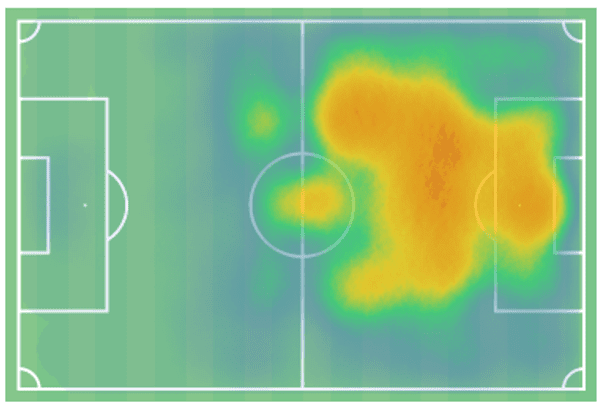
Goal-scoring prowess
As we have already touched upon, Alexander Jeremejeff’s biggest asset is his ability to score goals consistently. His record speaks for itself, and with an average xG of 0.67 per 90 and a goals-to-game ratio of 1.04, he clearly poses a constant threat to opposition defences. The analysis below will look at how he uses his speed and movement among other things to get himself into scoring opportunities.
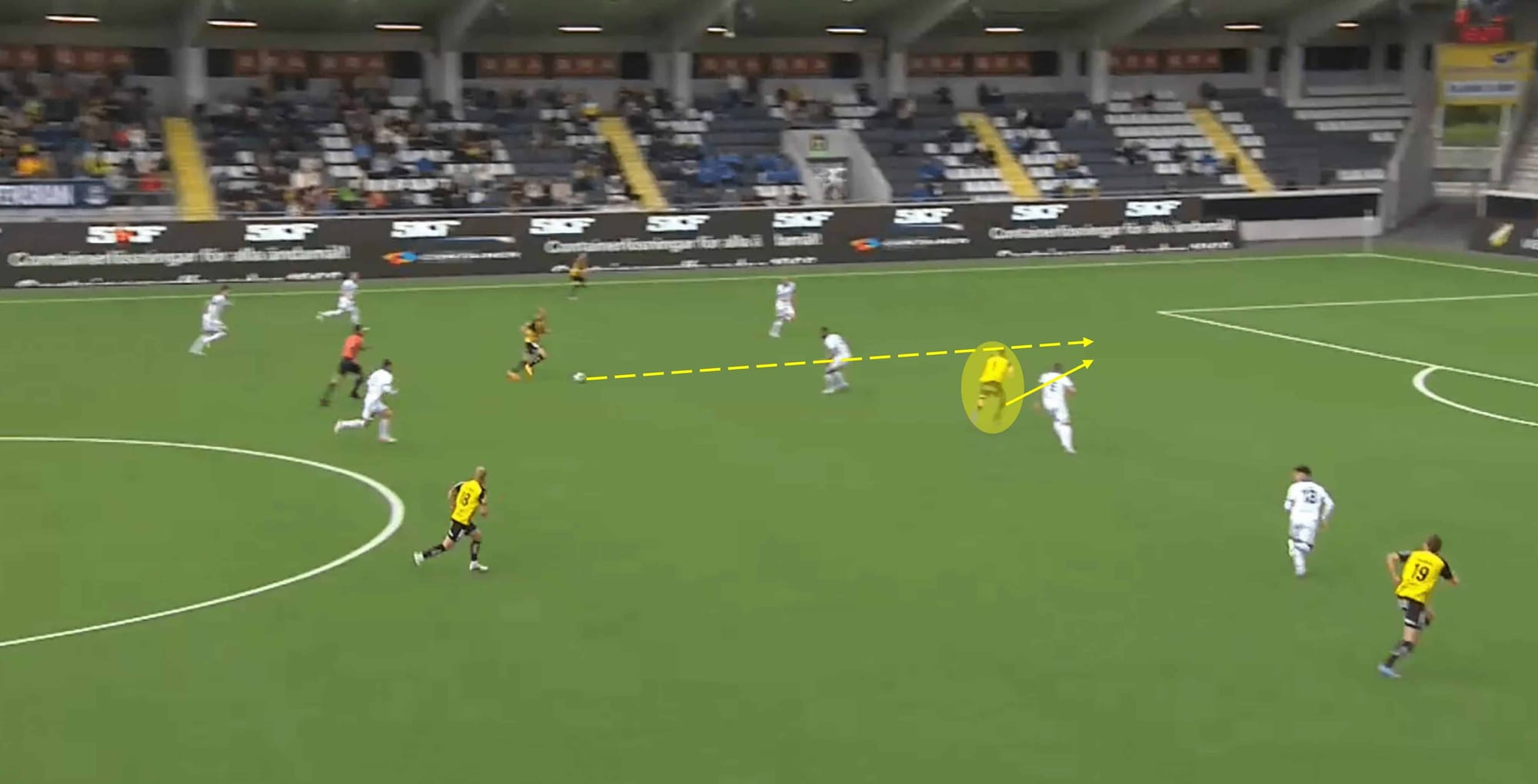
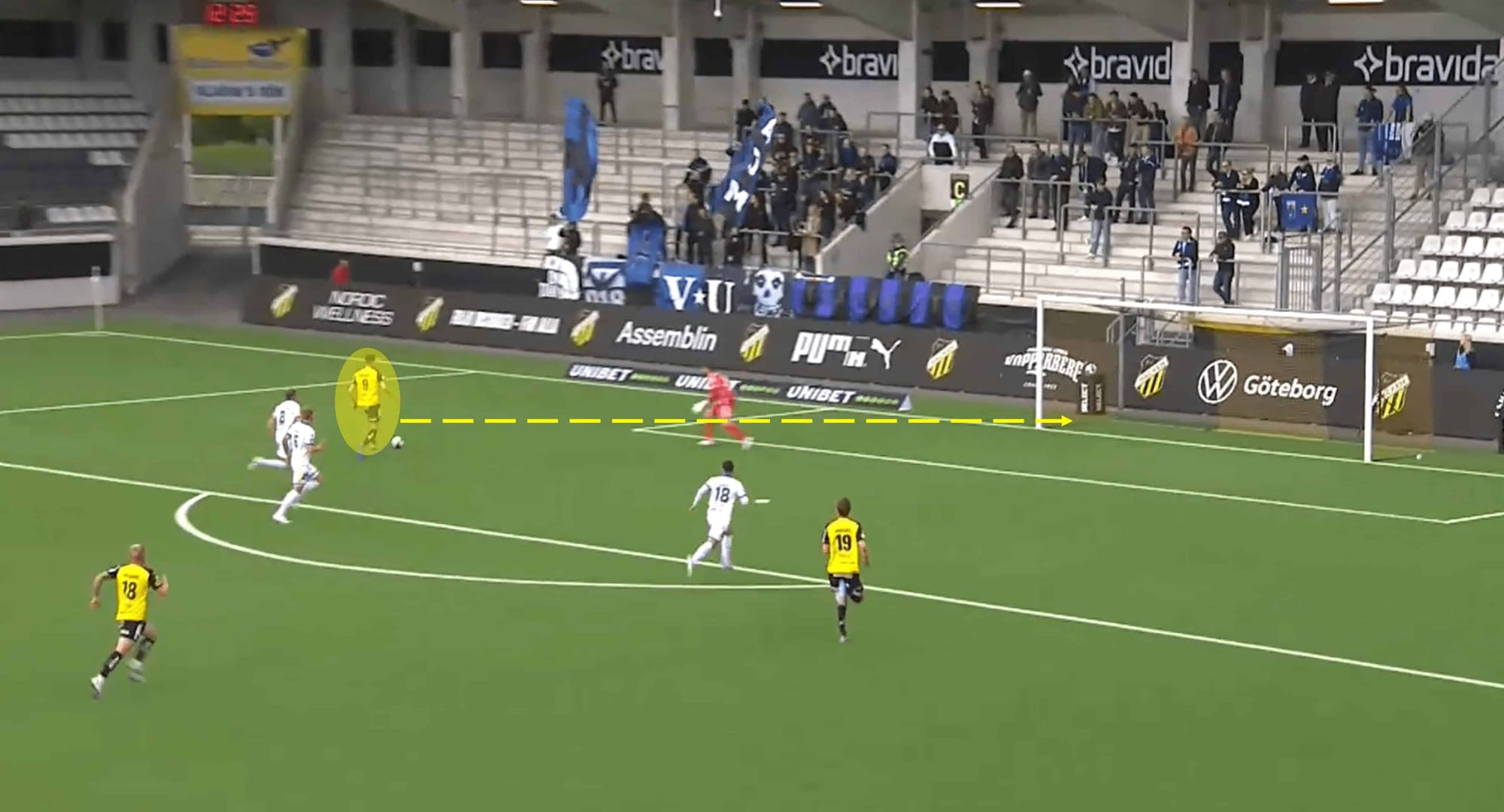
This first analysis shows Jeremejeff playing off the shoulder of the opposition CB, ready to launch a run into the space behind. Despite being 6ft3, he is deceptively quick for a man of his height and makes a quick, well-timed run which is matched by a comfortable control of the pass from his midfield teammate. From there, he finds himself one-on-one with the keeper, but he shows good composure to slot the ball past the keeper into the near corner. He made this all look very easy with his calm manner – it is even more impressive when you consider that he took the goal with his weaker left foot.
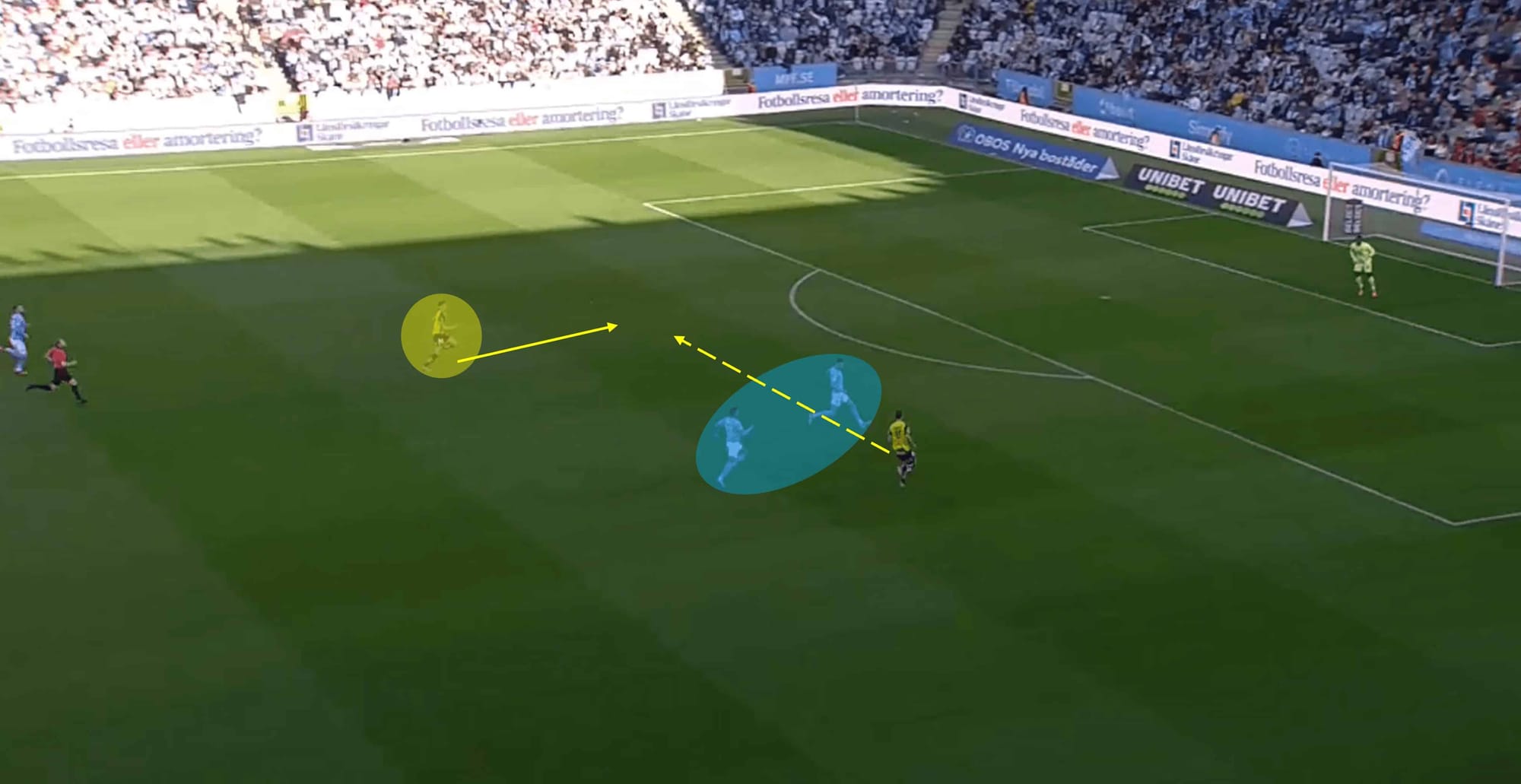
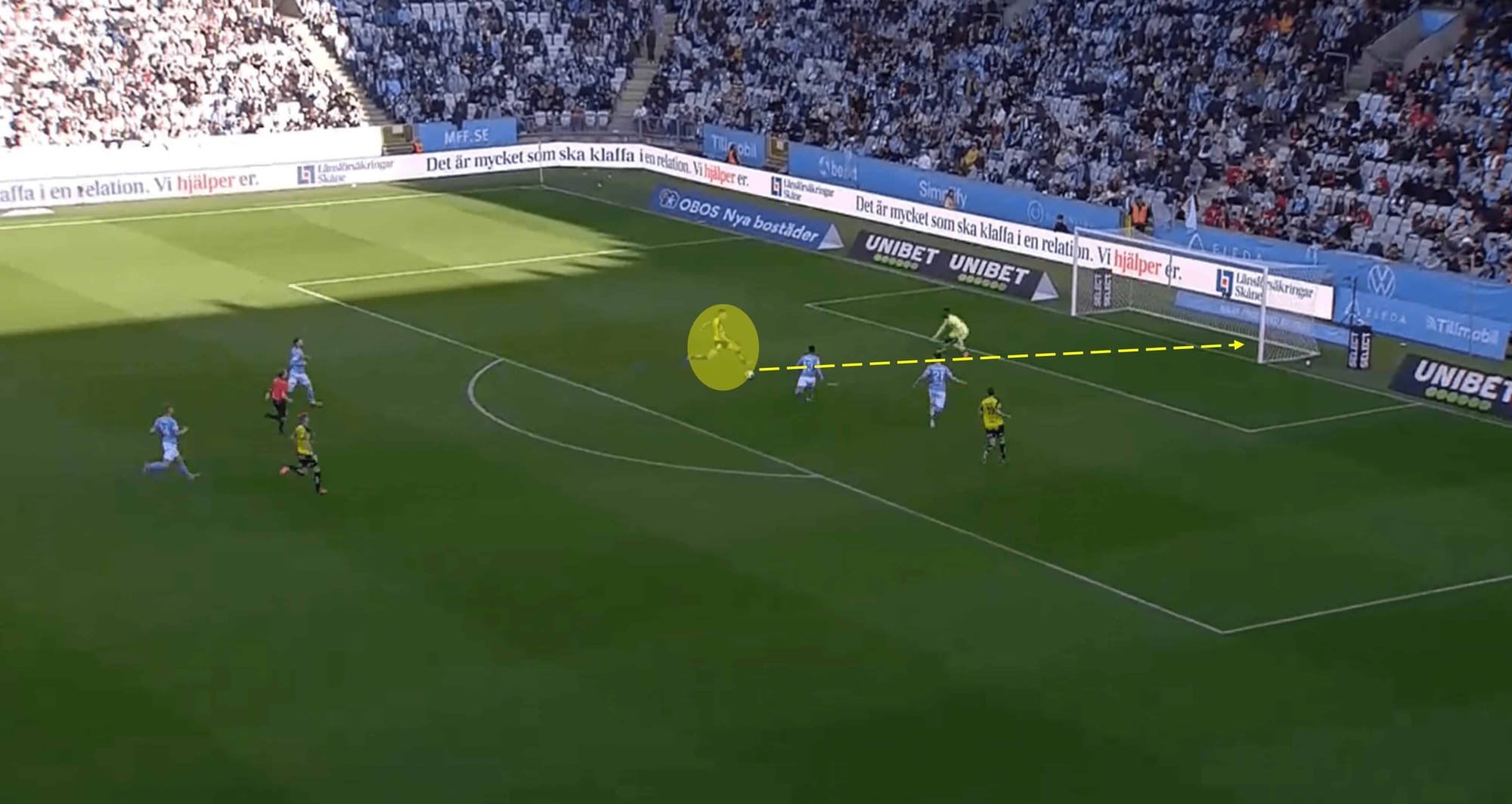
Another example of the forward using his movement to put himself in the best possible position for a goalscoring opportunity. During an attacking transition, his teammate is able to break away quickly and stays in that wider position to drag the defenders away, giving Jeremejeff more room. Jeremejeff keeps level with his teammate and receives the ball well, setting himself up for a simple, curled finish into the bottom corner using his stronger right foot.
Being able to stay calm and take up the best position is key and shows good tactical knowledge of the game, and his composure in controlling the ball and taking the shot was pure quality. Before he even received the ball, he knew in his mind what he wanted to do, and the positioning and timing allowed him to set the ball up on his right foot as he wanted to.
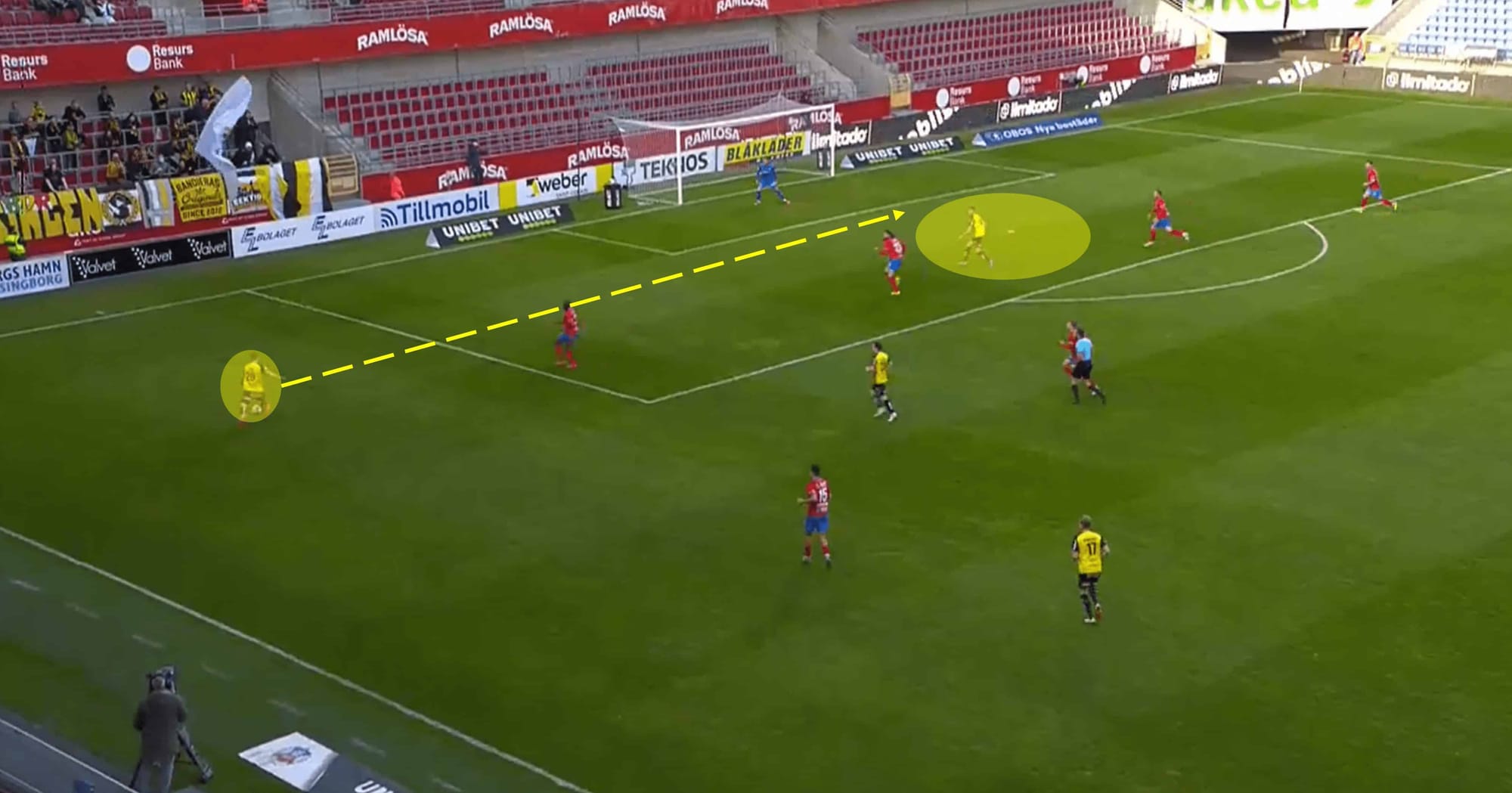
Considering this man’s height, it is a little surprising that aerial battling/heading isn’t his primary role – sometimes you find teams who deploy a big target man purely to win aerial balls or bully the defence, but Jeremejeff’s play style only incorporates elements of this every now and then. Here, he knows the gaps between the opposition defenders can be exploited and he’s able to drift away from tight marking to find himself in space. From there he is relying on the quality of the cross from his wide teammate – the cross is floated perfectly into place for Jeremejeff to unleash a bullet header past the keeper. Another display of good movement and positioning from the big man, with a classy finish to wrap it up.
Play-style in other areas
As we will see in the data discussion segment later in this analysis, there are some gaps in Jeremejeff’s game – parts of the game that aren’t the strongest of areas, and they all occur within attributes that don’t impact his goalscoring. However, he does have some impressive traits and abilities when getting himself involved in the build-up phase of an attack. The analysis below talks about his movement in deeper areas to link up with the midfield, as well as how he uses his size and strength to hold the ball and bring teammates into play.
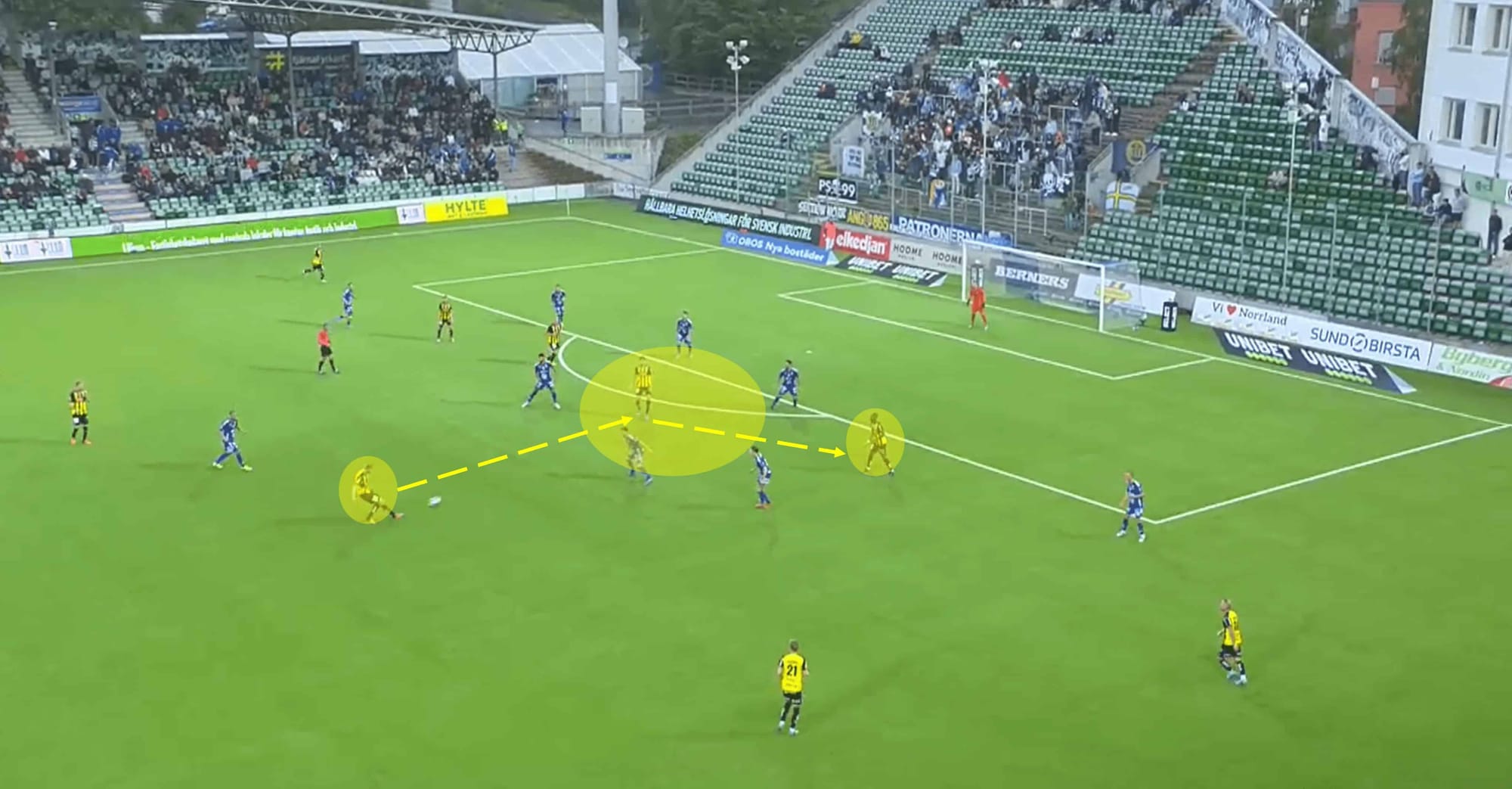
In this first example, Jeremejeff drops just a few yards deeper to locate himself in between the opposition midfield and defence. While he is technically surrounded by opponents, they’ve allowed him some space. The pass is pinged into the forward, who plays a deft first-time pass into the highlighted teammate, before making a move into a more supportive position in anticipation for the next phase.
Like much of his effective play, this is another simple move, but it allowed Häcken to progress the ball into a more dangerous area. Jeremejeff showed good movement and awareness as well as good technical aspects such as control and passing, all in one swift action.
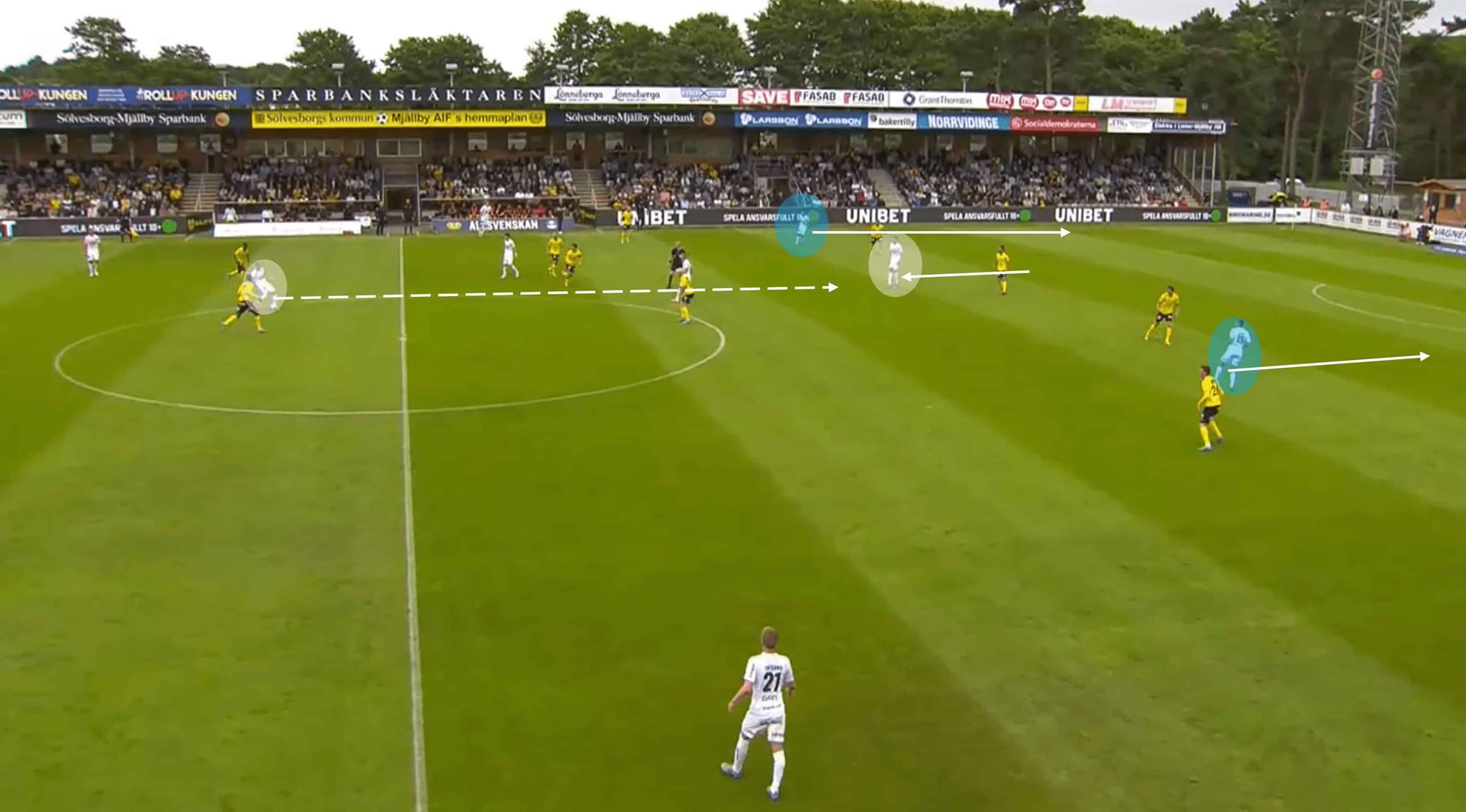
This example shows Jeremejeff executing a similar action to the previous one, just in a different setting. He drops a little deeper to lose his marker and make himself available for a line-breaking pass that would significantly speed up the attack. The pass reaches him, and his positioning allows both teammate wingers to make darting runs in behind to offer themselves as options and to also try and disrupt the opposition backline. In this instance, Jeremejeff shows good strength to keep the ball under pressure before playing the next pass.
While he often shows comfort and ability in dropping deeper to link up with the midfield, he struggles doing this with aerial balls – his headed passes often go astray or his touch is sometimes poor, leading to a turnover.
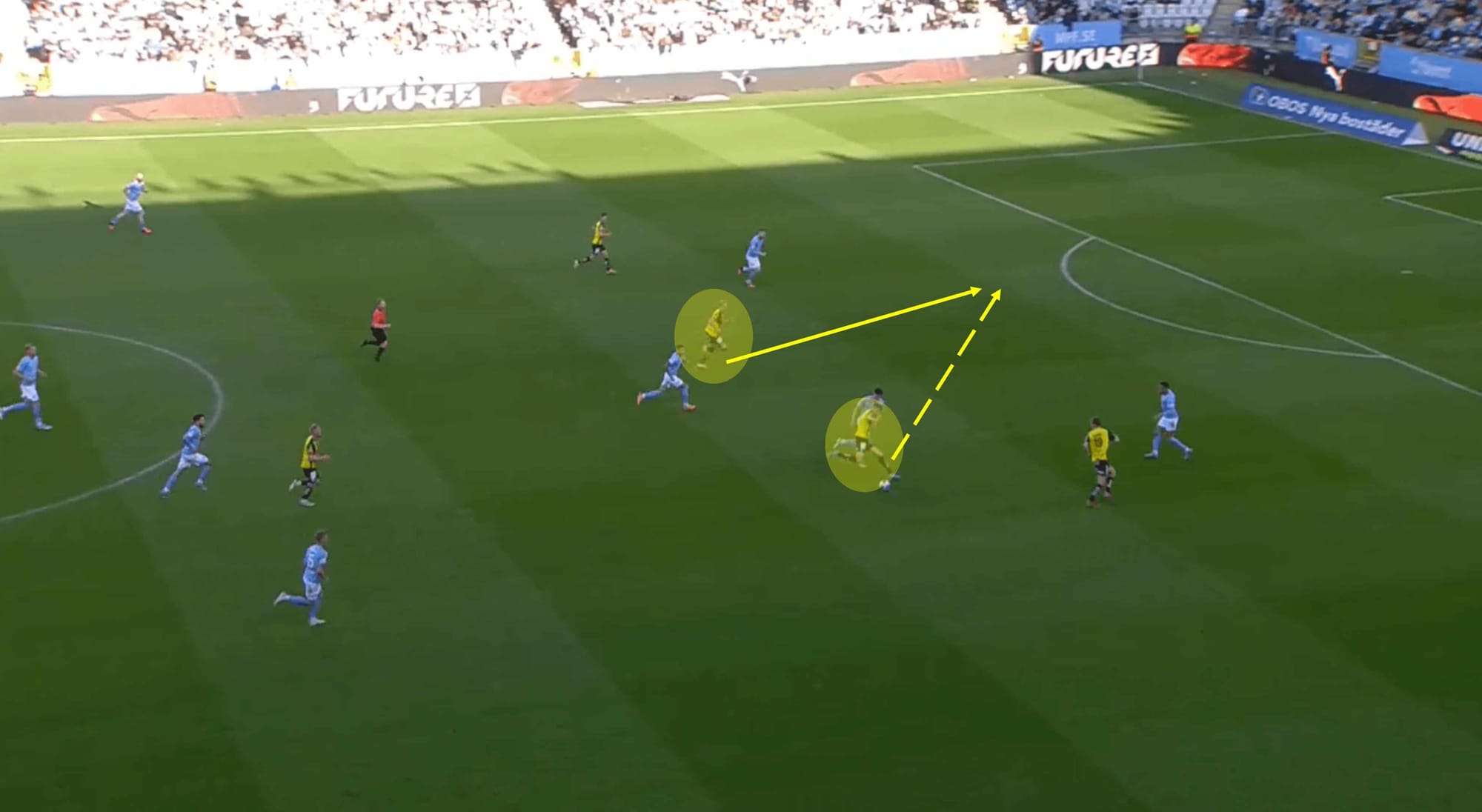
While he is the main goalscorer for Häcken, three assists in 13 games for a striker is not a bad return. Jeremejeff isn’t the best passer on a consistent basis, but he does have some ability up his sleeve to pull off important passes, as he shows above. Under strong pressure from the opposition, he keeps the ball well before hooking a pass in the opposite direction to which he is facing, finding the bursting run of his teammate, who is able to control the ball before placing it into the back of the net. This shows a good level of creativity and vision, as well as team chemistry and understanding to know where his teammate is.
Data discussion
To paint a clearer picture of the type of player Jeremejeff is, we will take a look at selected key data points for attributes such as passing, dribbling, duels, and more. This will help further help to decipher his quality aside from goalscoring aspects.
Aerial Duels: When it comes to challenges in the air, the 6ft3 striker averages 2.45 duels per 90 minutes, with a win rate of 36.4%. More attempts at an aerial challenge may be expected of a player so tall, but there is a point to be made that Häcken’s tactics just don’t require as many aerial duels from attackers as a direct team would. His win rate suggests he has some ability in winning headers but that it is not a trait to consistently rely on.
Defensive Duels: A striker’s defensive input can be very important, again depending on team tactics. Jeremejeff’s average of 2.23 defensive duels per 90 with a success rate of 30% suggests that he isn’t asked to contribute heavily to this area, but that he is capable of winning the ball on occasion.
Recoveries: A team can always cause sudden danger when their striker wins the ball back, and it can become even more dangerous if that occurs in the opposition half. Jeremejeff averages 1.78 recoveries per 90, with 58.3% of them being in the opposition half. This indicates that he doesn’t apply massive amounts of pressure outside of his own half, but is still able to cause quick turnovers to create the possibility of a counterattack.
Dribbling: A tall striker wouldn’t be expected to take the ball and glide past defenders to further an attack, and Jeremejeff is no exception – although his data suggests he could cause danger in this way. Averaging just two dribble attempts per 90 suggests he’d rather than leave it to his teammates while he takes up a supporting position in the box. However, his success rate of 44.4% tells us that he is capable of beating a player every now and then. Again, however, this is not a trait for Häcken to rely on.
Touches in the penalty area: As you may have guessed by now, Jeremejeff is most effective inside the box. His average of 3.56 touches in the box per 90 tells us that he is very active in this area of the pitch and looks to get involved where he can.
Passing: The stats for his passing paint a picture of someone who would be best suited to playing the simple pass before moving into a supporting/attacking position to contribute again later in the move. Overall passing accuracy of 70.4% suggests that he gives the ball away too much and should stick to the simple stuff. When it comes to his passing in a more attacking sense, he averages 1.11 passes into the final third and 1.41 passes into the penalty area – 60% and 68.4% respective accuracy rates. So while he is able to make a minor contribution to an attack in the build-up phase, he should focus his efforts on his movement and positioning to prepare for the end of the attack.
Conclusion
Häcken have never won the Allsvenskan title – the closest they ever came was back in 2012 when they finished second. The strong start to this year’s campaign, combined with the possession of a talented forward such as Alexander Jeremejeff gives them a good chance of ending that wait for a league title.
Jeremejeff has that “special-player” aura to him – a composure on the ball in important moments, strength and awareness to bring his teammates into play, and the ability to be clinical and find the net constantly. He is in his prime years and it shows, he is practically unplayable at the moment despite some of the flaws in his game. Alexander Jeremejeff could be the key to Häcken finally winning the league.

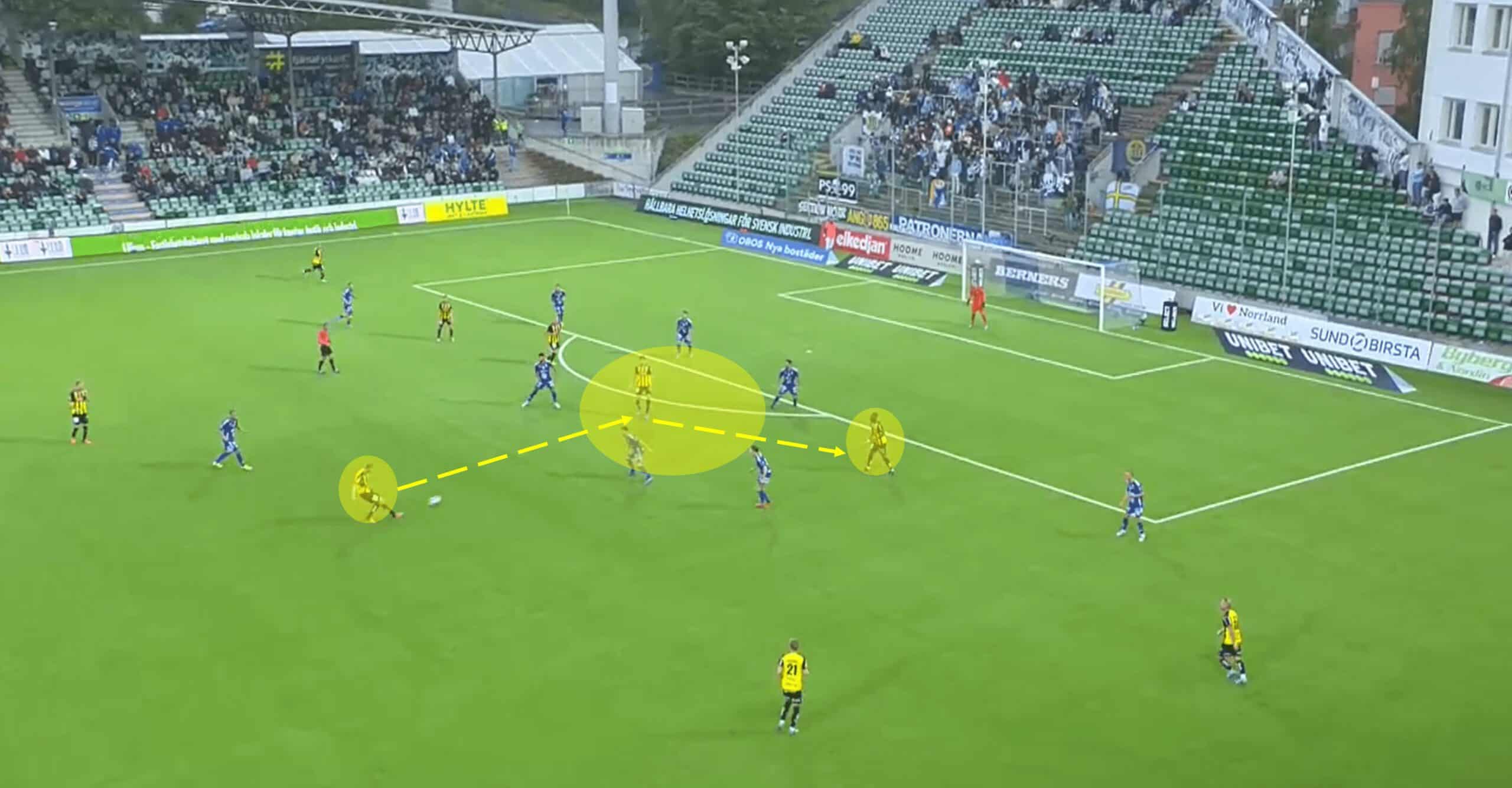




Comments